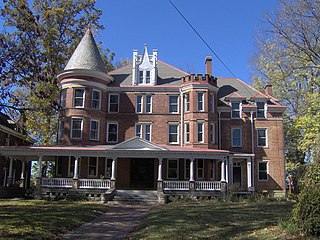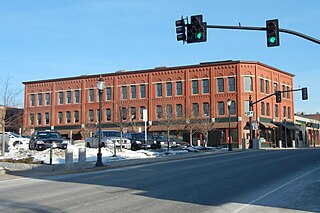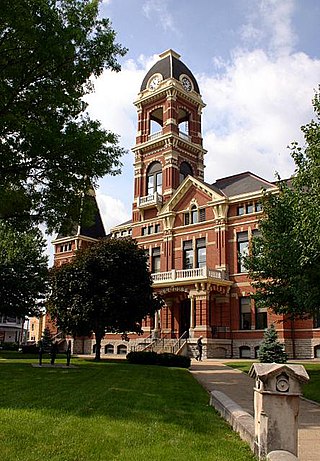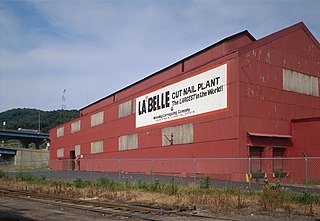
The Wood County Courthouse is a public building in downtown Parkersburg, West Virginia, in the United States. The courthouse was built in 1899 at a cost of $100,000 in the Richardsonian Romanesque style by local contractors Caldwell & Drake, according to the plans of architect L. W. Thomas of Canton, Ohio. The current courthouse is the fifth to be built in the county replacing one built in 1860. It was added to the National Register of Historic Places in 1979 for its architectural significance. During his 1912 presidential campaign Theodore Roosevelt stopped in Parkersburg and spoke from the Market street entrance of the courthouse. On 2 July 2020 a new steeple was added to the bell tower replacing one that had been removed in 1952. With the new steeple the courthouse is now the tallest in the state at 164 ft.

The Peter G. Van Winkle House was a historic home located in the Julia-Ann Square Historic District in Parkersburg, Wood County, West Virginia. It was built between about 1880 and 1899, and was a two-story duplex in the Queen Anne style. It featured a deck hipped roof with intersecting gables, turrets, and dormers. It was built on property once owned by former United States Senator Peter G. Van Winkle, who died in 1872.

The Julia-Ann Square Historic District, is a national historic district located at Parkersburg, Wood County, West Virginia. It is to the west of the Avery Street Historic District. It encompasses all houses on Ann and Juliana Streets from Riverview Cemetery to 9th Street. There are 116 contributing buildings and one contributing site. The majority of the houses were constructed between 1875 and 1915.

The Masonic Block is an historic commercial block in Reading, Massachusetts. This three-story brick building is distinctive in the town for its Renaissance Revival styling. It was built in 1894 by the local Reading Masonic Temple Corporation, and housed the local Masonic lodge on the third floor. The building was listed on the National Register of Historic Places in 1984.

This is a list of the National Register of Historic Places listings in Wood County, West Virginia.
The John W. Elliott House is a historic house in Eutaw, Alabama. The Creole cottage style structure was built in 1850 by Jesse Gibson for John Williams Elliott, a watchmaker and jeweler. Elliott was born in 1814 in Litchfield County, Connecticut. He migrated to Eutaw around 1840. Elliott married Louisa Elizabeth Towner, a teacher and native of Rutland County, Vermont, in 1843. They had three children, all born and raised in Eutaw. Louisa died in 1853. John then married Blanche Smith Chapman, a native of Virginia, in 1858. The Elliott family left Eutaw prior to the outbreak of the American Civil War and relocated to Brooklyn, New York, where John Elliott died in 1888. The house was placed on the National Register of Historic Places as part of the Antebellum Homes in Eutaw Thematic Resource on April 2, 1982, due to its architectural significance. It has been moved elsewhere since listing. The site is now a parking lot.

District B is a historic worker housing district located in Manchester, New Hampshire, United States, near the former Amoskeag Manufacturing Company millyard. It is roughly bounded by Canal, Mechanic, Franklin, and Pleasant Streets, and was added to the National Register of Historic Places on November 12, 1982. It contains 32 contributing properties, including seventeen rowhouse tenement blocks built mainly between 1838 and 1850, in an area of approximately 170 acres (69 ha).

Campbellton is a house near Gerrardstown, West Virginia built circa 1800 by James Campbell. Campbell, who was born in Ireland in 1744, arrived in America with his father in 1753, settling in Berkeley County, West Virginia in 1762. Campbell built a store on the property in 1780, along with a complex of accessory buildings, before building the main house.

Albert C. Nash (1825-1890) was an American architect best known for his work in Milwaukee and Cincinnati.

Lewis W. Thomas was an architect in Canton, Ohio. His work included the Wood County Courthouse in Parkersburg, West Virginia. He designed the Wood County Courthouse (1899), a Romanesque Revival structure added to the National Register of Historic Places on August 29, 1979.

Bethel African Methodist Episcopal Church was a historic African Methodist Episcopal church located at 820 Clay Street in Parkersburg, Wood County, West Virginia. It was built in 1887 and was a two-story, stucco building in a vernacular interpretation of the Gothic Revival style. It was one of three black churches in Parkersburg and was the oldest black church building in west-central West Virginia. The church was located in a neighborhood of late 19th-century wood-frame houses only a block from downtown.

The Elks Club was a historic clubhouse building located at Parkersburg, Wood County, West Virginia. It was designed by architect William Howe Patton and built in 1903. It was a four-story, three-bay by six-bay wide, red brick building with terra cotta trim in the Classical Revival style. The first two stories were faced in smooth dressed stone, and feature arched apertures, with central consoles. It was occupied by the Parkersburg Lodge #198, Benevolent and Protective Order of Elks (B.P.O.E.)
Mowbray & Uffinger comprised an architectural partnership in New York City formed in 1895. Known for bank buildings and as vault engineers they designed over 400 banks in the pre-World War II era throughout the country. The principals were Louis Montayne Mowbray (1867-1921) and Justin Maximo Uffinger Sr. (1871-1948).

Swan Pond Manor Historic District is a national historic district located near Martinsburg, Berkeley County, West Virginia, U.S.A. It encompasses 21 contributing buildings, one site, and one structure, over 2,465 acres. The agricultural district boundaries reflect the Swan Pond Manor land of Thomas Fairfax, 6th Lord Fairfax of Cameron, which he set aside in 1747 as a part of his Northern Neck Territory for his personal use. Notable buildings include the Capt. James Mason House, Kroh-Sprinkle House (1819), Jacob A. Small House, Robert Carter Willis House, Dr. Williams House, "Hollidale," and "Wood Haven" (1895), Raleigh Morgan House. Also located in the district is the separately listed Swan Pond.

Pocahontas Fuel Company Store, also known as Norfolk Coal & Coke Company Store and Henderson Market, was a historic Pocahontas Fuel Company company store building located at Maybeury, McDowell County, West Virginia. It was built before 1903, and was a one- to two-story wood-frame building on a stone foundation. It featured a pyramidal roof in one corner.

La Belle Iron Works, also known as La Belle Cut Nail Works, was a historic factory complex and national historic district located at Wheeling, Ohio County, West Virginia. The district included four contributing buildings; three Italianate style brick buildings dated to the founding of the company in 1852, and a tin plate mill built 1894–1897. After 1902, the buildings were combined under a single roof, although the truss systems date to different periods achieving the configuration visible today. When listed in 1997, it was known as the "La Belle Cut Nail Plant, The Largest in the World, Wheeling Corrugating Company, A Division of Wheeling Pittsburgh Steel Corporation." The cut nail machinery still in use by La Belle dated to 1852 and the 1860s. The machinery at La Belle along with the different processes were documented by the Historic American Buildings Survey team during the summer of 1990.

Citizens National Bank was a historic bank building located at Parkersburg, Wood County, West Virginia. It was built in 1898, and was a five-story, nine bay by three bay, masonry building in the Classical style. It featured a combination of arches, applied pressed metal ornamentation, and during its latter years, in the shadows of missing hollow metal, broken pediments.

The Oeldorf Building, also known as Wetherell's Jewelers, was a historic commercial building located at Parkersburg in Wood County, West Virginia, United States. It was built in 1906 and was a four-story, two-bay, brick building with a stone foundation and trim in the Classical Revival style. It had an intact first floor storefront and sidewalk clock.

The Elisha Pitkin House is a historic house at 173 High Woods Drive in Guilford, Connecticut. With a construction history estimated to date to 1690, it is one of Connecticut's small number of surviving 17th-century buildings. It was moved to this site in 1955 from its original site in East Hartford, and was listed on the National Register of Historic Places in 1979.




















